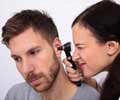Types
Some causes of dizziness are described below.
Dizziness is classified into the following 4 types:
Vertigo: Vertigo is the most common type of dizziness that people experience. The patients experience a false sense of motion, for example, they may complain that the room spins around them. Causes of vertigo are:
- Benign paroxysmal positional vertigo (BPPV): BPPV occurs due to the presence of small stones of calcium carbonate in the semicircular canals of the inner ear, which give a false sense of motion. The vertigo is episodic and is not accompanied by hearing loss. It is often accompanied by nausea and vomiting. The patient may experience a brief but intense episode of vertigo when he/she turns in bed at night or changes the head position. A test called the Dix-Hallpike maneuver is used to diagnose BPPV. During this test, the patient is in a seated position. The doctor turns the patient’s head 45 degrees to one side, then quickly puts the patient in lying down position with the head hanging about 20 degrees over the end of the table. The test is then repeated for the opposite side. Nystagmus or rapid involuntary movement of the eyes during the test is diagnostic of BPPV.
- Vestibular neuritis: A viral infection of the vestibular nerve results in vestibular neuritis. The patient usually does not suffer from hearing loss. The vertigo is persistent. Abnormal eye movements may be present.
- Labyrinthitis: Labyrinthitis or infection of the labyrinthine organs results in vertigo with hearing loss. The vertigo is persistent and may be preceded by a recent upper respiratory tract infection.
- Meniere disease: Meniere disease occurs due to increase in fluid pressure in the inner ear. It is usually accompanied by hearing loss and tinnitus (abnormal sounds in the ear) and occurs in episodes.
- Perilymph fistula: Perilymph fistula is a condition where there is leakage of inner ear fluid into the middle ear. It may be present from birth or develop following trauma like head injury, drastic changes in atmospheric pressure, physical exertion, ear surgery, or chronic ear infections. It results in unsteadiness when walking or standing that increases with activity and decreases with rest.
- Migrainous vertigo or vestibular migraine: Migraine can co-exist in patients with vestibular disease. Patients with migrainous vertigo suffer from episodic migraine and in addition from migraine headache, photophobia, phonophobia or aura during at least two episodes of vertigo.
- Other central causes: Tumors, stroke or other conditions affecting the brain especially the areas involved in balance result in vertigo. These are more serious causes of vertigo. A patient with a central cause is severely unstable and cannot walk or stand without falling.
Disequilibrium: A patient with disequilibrium feels off balance and wobbly. In disequilibrium, the brain does not receive adequate information about the body’s position from the various senses like the eyes and inner ears. The reasons for imbalance could be:
- Stroke: A stroke is one of the reasons for imbalance. It is also accompanied by other symptoms of stroke.
- Poor vision: Poor vision can lead to imbalance, resulting in falls.
- Nerve and muscle related disorders: Other disorders that could cause imbalance are those that can affect nerves and muscles like Parkinson disease, peripheral neuropathy, and musculoskeletal disorders that may affect gait.
- Drugs acting on the brain: Drugs that act on the brain like benzodiazepines and tricyclic antidepressants can cause imbalance and falls especially in older individuals.
Presyncope: A patient with presyncope gets a feeling of losing consciousness or blacking out. Presyncope usually occurs due to a fall in blood pressure, often due to a heart-related cause. This results in reduced blood circulation to the brain and a feeling of dizziness. Causes of presyncope are:
- Abnormal heart rhythms like supraventricular tachycardias and heart attack. Cardiac tests may help to diagnose these conditions.
- Narrowing of the carotid artery (the artery that supplies blood to the brain). In addition, cervical spondylosis may also restrict the blood supply to the brain resulting in dizziness.
- Orthostatic hypotension: Blood pressure that falls with changes in posture is referred to as orthostatic hypotension. The blood pressure is recorded in lying down posture and then again in the standing posture. A fall in the systolic blood pressure of 30mm of Hg, diastolic blood pressure of 10mm of Hg or an increase in pulse of 30 beats per minute is indicative of orthostatic hypotension. A number of medications like reserpine, doxazosin and clonidine can cause orthostatic hypotension.
Lightheadedness: A patient with lightheadedness complains of vague symptoms like feeling disconnected with the environment. Causes of lightheadedness include:
- Psychiatric causes: Psychiatric causes like anxiety, depression and panic disorder can cause lightheadedness.
- Alcohol intoxication: Alcohol intoxication can also cause lightheadedness.
- Hyperventilation syndrome: Patients with hyperventilation syndrome breathe excessively fast. This may give rise to abnormalities in the pH of blood resulting in lightheadedness. The patient may suffer from additional symptoms like chest pain, paresthesias, bloating and pain over the stomach region.












